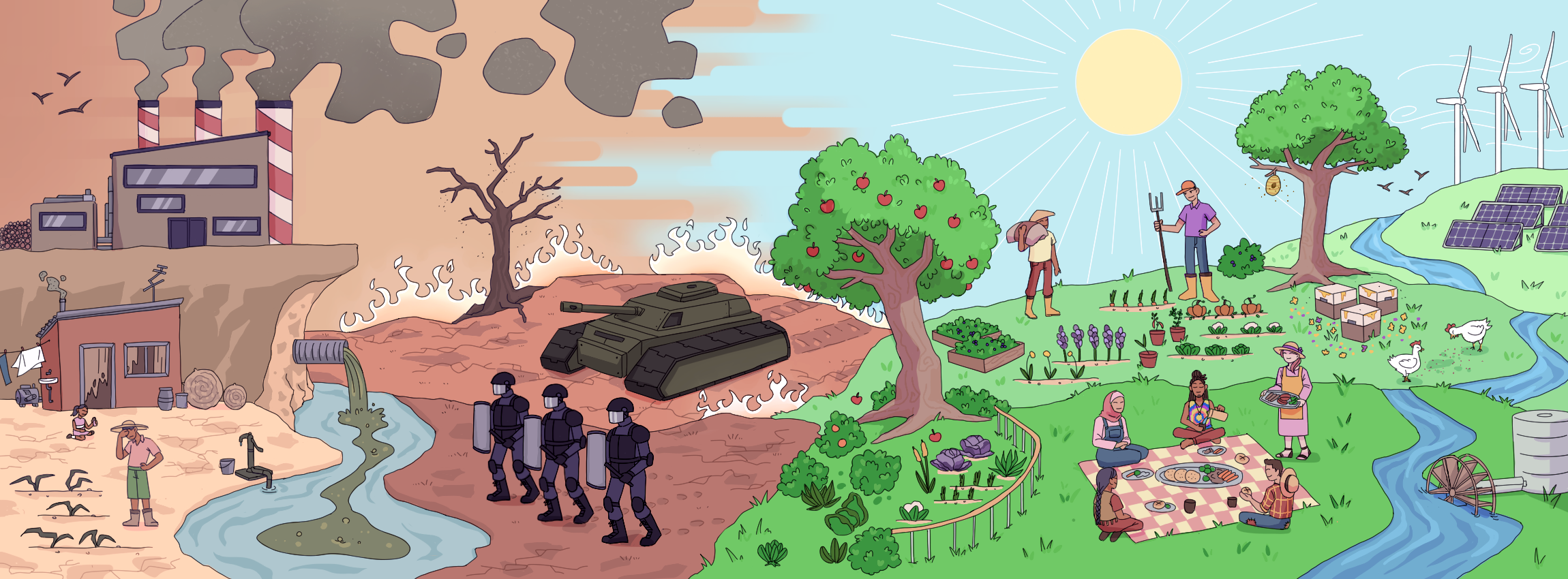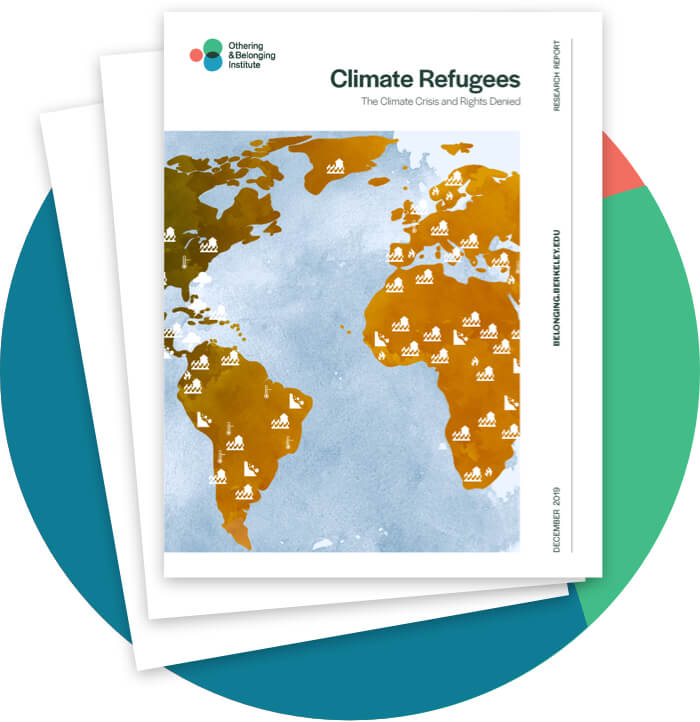Ecuador
Introduction to Ecuador
Ecuador is a small, mega-diverse country in northwest South America that has a population of 18.2 million,1 of which 35% is rural.2 As a coastal country, Ecuador has several climatic zones; the southwestern region has a hot semi-arid climate, the eastern half has a tropical rainforest climate, and the central part—where the Andes Mountain chain is situated—has a temperate oceanic climate.3 Due to this cross-country variability, Ecuador has been subjected to extreme weather events like increased droughts, rainfalls, and floods.4 This can prove consequential to Ecuador’s highly concentrated urban population, as 64.8% of Ecuadorians live in cities, and the urban growth rate is steadily increasing at 1.62%.5 Nearly 96% of this urban population lives near the coast or mountainous areas, making them highly susceptible to the impacts of the climate crisis.6 Although Ecuador has an unemployment rate of only 3.2% and is considered a middle-income country, over 27% of the nation lives below the poverty line and only 35% of the working-age population is fully employed.7 Additionally, the economy has substantially slowed down compared to its Latin American counterparts. In 2023, Ecuador’s GDP only grew by 2.4%, and 55% of industries reported interannual decreases in Q4.8 Economic growth in 2024 is projected to be even lower at 1.0%.9 The service and manufacturing sectors comprise 59.7% and 26.9% of GDP, respectively, while agriculture makes up 7.7% of GDP.10 Part of the manufacturing sector, crude oil alone makes up 26% of total exports, 6% of GDP, and 21.7% of total revenue.11 Ecuador has a young population, with 38% of the population under 20 years old.12 While 71.9 % of Ecuador’s population identifies as mestizo—mixed-race Spanish and Native mix–there are 18 Indigenous peoples and 14 distinct Indigenous nationalities.13
Mapping Major Climate Events and Climate-Induced Displacement
Ecuador is highly susceptible to the effects of the climate crisis, ranking as the 63rd most vulnerable country and 129th in readiness.14 Geographically, this is due to Ecuador having several climatic regions while frequently facing the El Niño Southern Oscillation, which triggers and intensifies natural disasters such as droughts and floods,15 and which itself is being exacerbated under the climate crisis. For example, the 1997 El Nino-associated storm systems–where 57% of the country was considered at risk, 286 individuals died, 30,000 individuals became homeless, and 112,000 agricultural jobs were affected–has prefigured climate impacts in recent years.16 In 2023, extreme rainfall led to widespread flooding and structural collapse, resulting in 126,922 affected individuals, 4,128 displacements, 37 deaths, and 533 destroyed homes.17 Roughly 29% of the country is constantly exposed to floods and such impacts.18 Conversely, in November 2009, there was a massive drought in Ecuador that affected 107,500 people.19 Further, because 78% of Ecuador’s electricity comes from hydroelectric plants,20 this drought prompted a massive electricity crisis, resulting in massive social and economic implications for the country.21 Overall, between 2008-2023, 102 storms and floods have resulted in 70,000 internal displacements in Ecuador.22 Another key climate impact facing Ecuador, global warming has melted 33% of glacier cover in the Andes Mountains range, resulting in an irreversible loss of freshwater for many downstream rural communities that rely on it for survival.23 Rural, Indigenous, and impoverished communities are disproportionately affected by the climate crisis, as they often already face lower food security, experience poor living conditions in flood-prone zones, and have limited accessibility to vital resources during times of need.24
Mapping the Costs of the Climate Crisis
The GDP of Ecuador is $118.84 billion,25 while the GDP per capita is $6,533.26 Although Ecuador’s financial success over the past 20 years may be significant, recent economic growth has slowed down tremendously, and the worsening of the climate crisis will only deepen these challenges and losses. It is projected that by 2050, climate change will impact 14% of GDP tied to agriculture, and 80% of crops could be impacted if no adaptation occurs.27 Further, rice production can decrease by 3% to 60%, potato yields may drop by 34%, and heat stressors can significantly reduce cattle milk production and reproduction rates.28 Looking at historical examples, the 1997 El Nino caused immense economic loss that is still felt by Ecuador today. Over $280 million of damage—15% of 1997 GDP—was suffered,29 11% of rural workers lost their jobs, the poverty rate increased by 11%, workers lost $73.9 million of potential earnings, and the country lost out on $99 million of potential crop exports.30 However, the increased rainfall also brought positives, as warmer waters led shrimp production and exports to rise by 26%, which partially helped offset agricultural losses.31
Mapping Resilience and Mitigation Pathways
Despite being responsible for 0.20% of global GHG emissions,32 Ecuador continues to work towards reducing emissions and mitigating the damage of the climate crisis. In 2008, Ecuador became the world’s first country to include ecosystem rights in its national constitution, where the state prohibits any extraction of non-renewable resources in protected areas and strongly discourages monocropping.33 Starting in 2019, Ecuador’s Nationally Determined Contributions (NDCs) targeted a 20.9% reduction in BAU emission levels by 2025, 9% being unconditional and the other 11.9% being conditional on international cooperation.34 Mitigation tactics currently focus on energy, waste, industrial processes, agriculture, and land use sectors.33 The energy industry produces 60.6% of total GHG emissions,35 with fossil fuels making up 87.5% of all energy,36 prompting the country to look towards new avenues to disincentivize oil use and promote renewable energy. This included a May 2020 reform that heavily reduced gas and diesel subsidies in Ecuador to allow more efficient energy use.33 As Ecuador transitions to a low-carbon economy away from fossil fuels, this high dependency on oil has a significant physical and economic transition risk for domestic production and global oil imports. This transition may occur even earlier than expected, as in 2023, 60% of Ecuadorians voted against oil drilling in the Ecuadorian Amazon, illustrating the people’s disinterest in the continued extraction of fossil fuels.37 Although renewable energy through hydropower helps produce 79% of Ecuador’s electricity, it is not reliable long term because of vulnerability to droughts and low water levels, keeping the country tethered to oil-fired power plants as a supplement under challenging times.38 Further, since this supply does not account for the growing energy demand within Ecuador, the government began offering 100% income tax exemptions for those who make certain investments in renewable energy.39 Deforestation has been a significant problem for the country, as Ecuador has lost nearly 2.9 million acres of natural land and 16.4% of all mangroves over the past 37 years.40 In response, Ecuador has pledged to reduce land use change emissions by 4% and reforest at least 210,000 hectares of cleared land.41
Necessary Changes
Although Ecuador has already taken preemptive measures to address the climate crisis, it must continue to identify and implement new adaptations for the future while strengthening existing strategies. This includes prioritizing agriculture, health, human settlements, food safety, water, and natural heritage sectors for adaptation, as all will be impacted by climate change.42 Land planning techniques must be revamped and implemented across the geography, as Ecuador has continuously failed to create sustainable agriculture methods and conserve natural habitats.29 Economically, Ecuador has to shift from oil to diversified and sustainable exports in the long run, such that they are resilient from natural disasters and to the transition to a low-carbon economy, and meaningfully benefit the country’s residents.33 Ecuador must also work on institutional capacity building, as ineffective government policies create gaps between national climate strategy and local and regional implementations, greatly hindering domestic cooperation.43 However, the biggest challenge lies in the financials; it is estimated that Ecuador must annually invest 3.5% of GDP—$3.7 billion—in mitigation and adaptation activities to adequately protect their country from the impacts of the climate crisis.44 These costs must be borne by those countries and corporations historically responsible for contributing the most to the climate crisis.
Citations
- 1“Population, total – Ecuador,” The World Bank, October 10, 2024,
https://data.worldbank.org/indicator/SP.POP.TOTL?locations=EC. - 2Rural Population, total – Ecuador,” The World Bank, accessed October 10, 2024, https://data.worldbank.org/indicator/SP.RUR.TOTL.ZS?locations=EC.
- 3“Climate Change Knowledge Portal – Ecuador,” The World Bank, accessed October 10, 2024,
https://climateknowledgeportal.worldbank.org/country/ecuador. - 4“Climate Risk Country Profile - Ecuador,” The World Bank, accessed October 10, 2024,
https://climateknowledgeportal.worldbank.org/sites/default/files/countr…. - 5“The World Factbook - Ecuador,” CIA, accessed October 10, 2024,
https://www.cia.gov/the-world-factbook/countries/ecuador/. - 6“Ecuador’s Recent Natural Disasters: A Worrying Indicator of Climate Change,” IR Review, accessed October 10, 2024,
https://www.irreview.org/articles/ecuadors-recent-natural-disasters-a-w…. - 7“Ecuador - Country Commercial Guide,” ITA, accessed October 10, 2024,
https://www.trade.gov/country-commercial-guides/ecuador-market-overview. - 8“Ecuadorian Economy Recorded a Growth of 2.4% in 2023,” Central Bank of Ecuador, accessed October 10, 2024,
https://www.bce.fin.ec/en/press-release/ecuadorean-economy-recorded-a-g…. - 9Ibid. (i).
- 10“The World Factbook - Ecuador,” CIA.
- 11“Ecuador: Selected Issues,” IMF, accessed October 11, 2024,
https://www.elibrary.imf.org/view/journals/002/2021/229/article-A005-en…. - 12“The Potential and Challenges of Ecuador,” UNFPA Ecuador, accessed October 10, 2024,
https://ecuador.unfpa.org/en/potential-and-challenges-ecuador. - 13Ibid. (ii).
- 14“Ecuador - ND-GAIN Index,” University of Notre Dame Global Adaptation Initiative, accessed October 10, 2024,
https://gain-new.crc.nd.edu/country/ecuador. - 15“Climate Change; Ecuador,” Interactive Country Fiches UNEP, accessed October 10, 2024,
https://dicf.unepgrid.ch/ecuador/climate-change. - 16“Economic and Social Effects of El Niño in Ecuador, 1997-1998,” Inter-American Development Bank, accessed October 10, 2024,
https://webimages.iadb.org/publications/english/document/Economic-and-S…. - 17“Ecuador: Floods + Earthquake - March 2023,” IFRC, accessed October 10, 2024, https://reliefweb.int/report/ecuador/ecuador-floods-earthquake-march-20….
- 18“Addressing Human Mobility in a Changing Climate in Mountain and Coastal Areas of Ecuador - Second Phase,” IOM, accessed October 10, 2024, https://www.iom.int/project/addressing-human-mobility-changing-climate-….
- 19 “Ecuador’s Recent Natural Disasters: A Worrying Indicator of Climate Change,” IR Review.
- 20“El Niño weather is leading to droughts and power cuts in South America,” NPR, accessed October 10, 2024,
https://www.npr.org/2024/05/01/1247847802/drought-south-america-el-nino…. - 21“Ecuador’s Worst Drought in 50 Years Triggers Power Cuts,” The Rio Times, accessed October 10, 2024,
https://www.riotimesonline.com/ecuadors-worst-drought-in-50-years-trigg…. - 22“Ecuador Displacement Data,” IDMC, accessed October 19, 2024,
https://www.internal-displacement.org/countries/ecuador/ - 23“Report shows loss of natural land cover in Ecuador — and where it can still be saved,” Mongabay, accessed October 10, 2024,
https://news.mongabay.com/2024/01/report-shows-loss-of-natural-land-cov…. - 24Climate Risk Country Profile - Ecuador,”The World Bank.
- 25“GDP (current US$) - Ecuador,” The World Bank, accessed October 10, 2024, https://data.worldbank.org/indicator/NY.GDP.MKTP.CD?locations=EC.
- 26“GDP per capita (current US$) - Ecuador,” The World Bank, accessed October 10, 2024,
https://data.worldbank.org/indicator/NY.GDP.PCAP.CD?locations=EC. - 27“Climate Risk Country Profile - Ecuador,” The World Bank.
- 28Ibid. (iii).
- 29 a b “Ecuador’s Recent Natural Disasters: A Worrying Indicator of Climate Change,” IR Review.
- 30“Economic and Social Effects of El Niño in Ecuador, 1997-1998,” Inter-American Development Bank.
- 31Ibid. (iv).
- 32“Global Climate Promise - Ecuador,” UNDP, accessed October 13, 2024,
https://climatepromise.undp.org/what-we-do/where-we-work/ecuador. - 33 a b c d “Ecuador: Selected Issues,” IMF.
- 34“IGES NDC Database,” Institute for Global Environmental Strategies, accessed October 13, 2024,
https://www.iges.or.jp/en/pub/iges-indc-ndc-database/en. - 35“Greenhouse Gas Emissions in Ecuador,” Emission Index, accessed October 13, 2023, https://www.emission-index.com/countries/ecuador.
- 36“CO2 emissions from service sectors in Ecuador: an analysis using input–output subsystems,” PAPAIOS, accessed October 13, 2023,
https://journalofeconomicstructures.springeropen.com/articles/10.1186/s…
- 37“Ecuador Will Keep Some Oil in the Ground,” The New York Times, accessed October 11, 2024,
https://www.nytimes.com/2023/08/22/climate/ecuador-will-keep-some-oil-i…. - 38“Ecuador has continued to expand use of hydroelectric power,” EIA, accessed October 13, 2024, https://www.eia.gov/todayinenergy/detail.php?id=60442#:~:text=In%202021….
- 39Ibid. (v).
- 40“Report shows loss of natural land cover in Ecuador — and where it can still be saved,” Mongabay.
- 41“How Ecuador is protecting the Amazon forest,” UNDP, accessed October 13, 2024, https://climatepromise.undp.org/news-and-stories/how-ecuador-protecting….
- 42“IGES NDC Database,” Institute for Global Environmental Strategies.
- 43Ibid. (vi).
- 44“Strategic Investments Can Drive Ecuador toward Resilient, Low-emissions Development,” World Bank, accessed October 13, 2024,
https://www.worldbank.org/en/news/press-release/2024/09/19/las-inversio….


